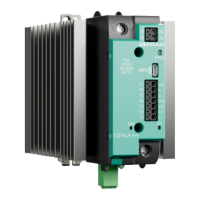819XX_MAN_GRM-H_11-2022_ENG_pag. 35
5.2.1. HB (Heat Break) Alarm
This type of alarm makes it possible to identify
breakage (partial or total) or interruption of the load
through the measurement of the current delivered,
obtained by means of an integrated current sensor.
The following three fault situations can occur:
• The current delivered is lower than the rated current
recorded during calibration: this is the most common
situation and indicates that an element of the load
has failed.
• The current delivered remains significant even
during periods when it should be zero: this is a
situation of load drive circuit short-circuit or due to
relay contacts welded together. Prompt intervention
in these situations is very important to prevent
greater damage to the load and/or the pilot circuits.
The device controls the power flow through alternating
ON (operating) and OFF (non operating) states,
modulating according to the set cycle time, or
according to the digital command.
The current reading taken during the ON phase
makes it possible to identify an abnormal deviation
from its rated value due to a fault on the load (the first
fault situation listed above). The current reading taken
during the OFF phase makes it possible to detect
a possible fault on the SSR control, resulting in an
output that is always active (second fault situation).
The alarm is enabled by means of the Hd.E
parameter and the type of function required is
selected with the Hb.F parameter:
• Hb.F = 0: the alarm is triggered if the current load
value is below the threshold value set in A.Hbx
while the SSR control output is ON.
• Hb.F = 1: the alarm is triggered if the current load
value is above the threshold value set in A.Hbx
while the SSR control output is OFF
• Hb.F = 2: the alarm is triggered by joining functions
0 and 1 with a logical OR.
The A.Hbx = 0 setting disables both types of HB
alarm by forcing the Alarm status off.
The alarm is reset automatically if its cause is
eliminated.
An additional configuration parameter for each zone,
related to the HB alarm is:
Hb.t = wait time for HB alarm trigger, intended as the
sum of the times for which the alarm is considered on.
For example, with:
• Hb.F = 0 (alarm on with current below the set
threshold value),
•
• Hb.t = 60 s and control output cycle time = 10 s,
•
• Power delivered at 60%, the alarm will trigger after
100 s (output ON for 6 s each cycle); and if the
delivered power is 100%, the alarm will trigger after
60 s.
If the alarm goes off during this interval, the time sum
is reset.
The delay time set in Hb.t must exceed the cycle time
of the SSR output.
5.2.1.1. HB alarm threshold teach-in/calibration
function
This function allows teach-in of the HB alarm
threshold.
To use this function, it is first necessary to set the
Hb.P parameter, which defines the percentage of
current in relation to the rated load below which the
alarm is triggered.
The function can be activated by digital input, by
serial command (Modbus bit 14), IO-Link, (see
Inputs "Table 1 System command values"
on page 79) or to key (see Inputs "3.1.4. Key"
on page 24).
When the Teach-in function is activated in FCT, BF
and HSC modes, the RMS current value in operating
ON multiplied by the Hb.P parameter determines the
HB alarm threshold.
When the Teach-in function is activated in PA mode,
the RMS current value is recalculated at 100%
power, which, when multiplied by the Hb.P parameter,
determines the HB alarm threshold.
Before activating the function, the SSR must be
activated by the digital input (for model GRM-Hxx-AN-
xxx-xx-x with digital input function set as Main SSR)
or switched on with power, recommended greater
than 50% (for models GRM-H-x-x- AN-x-x-x-x-x-x e
GRM-H-x-x-I-x-x-x-x-x-x).
The measured current threshold will be written
automatically in the A.Hb parameter.
In the case of HSC or PA mode for infrared lamps
(see parameter PS.E=3) the function activates
automatic power/current curve reading, useful for
determining the HB alarm threshold.
Automatic reading of the power/current curve takes
place in the following sequence:
- ssoftstart at maximum power (default 100%), 5
second delay;
- power reduction to 50%, 30%, 20%, 15%, 10%, 5%,
3%, 2%, 1% between each value 5 sec delay
- return to normal operation.
Maximum conduction value in this phase can be
limited by means of the parameter Hb.Pm
In HSC mode, the HB alarm threshold teach-in
function does NOT calibrate at 5%, 3%, 2%, 1% to
avoid high peak currents due to low impedance for
the low temperature of the IR lamp filament.
5.2. Alarms

